
|
 |
 |
 |
 |
What do zebra mussels look like?
|

|
NOAA, Great Lakes Environmental Research Lab
Zebra mussels on a stick
Photo by Simon van Mechelen, University of Amsterdam, 1990.
Click image to enlarge
|
- Zebra mussels get their name from the striped pattern of their shells. However, the pattern varies greatly to where there are no stripes, only dark or light colored shells. Zebra mussels can grow to a maximum length of about 50 mm (5-10 mm in the first year) and live four to five years.
|
|
Top of Page
|
Why are zebra mussels considered to be a nuisance?
|
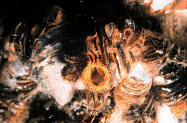
|
NOAA, Great Lakes Environmental Research Lab
Zebra mussels filtering water.
Photo by W. Brusate, Marine City, MI, 1995.
Click image to enlarge
|
- Ecological Impacts - Zebra mussels have disrupted the traditional aquatic food chains of many
inland lakes. Regardless of their size, inland lakes represent unique ecological systems. When zebra mussels enter into these fragile systems, their voracious filter feeding depletes the availability of microscopic organisms that play a critical part in each lake's ecological food web. As a result, valued sportfish are impacted. Zebra mussels consume considerable amounts of these beneficial microscopic organisms and this creates less food for larval and juvenile fishes that support sport and commercial fisheries.
- Biological Impacts - Zebra mussels

|
NOAA, Great Lakes Environmental Research Lab
Zebra mussels attached to native clam compared to native clam alone.
Photo by J. Schloesser, USGS.
Click image to enlarge
|
are similar to other mussel species because they attach
themselves to hard surfaces. However, unlike other species, zebra mussels will readily attach themselves to native mussels. This behavior is known as bio-fouling and with the spread of zebra mussels, native mussel populations have been
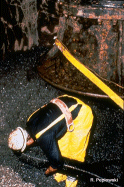
|
Worker removing zebra mussels from Detroit Edison water intake pipes.
Photo by Ron Peplowski Detroit Edison, Monroe Michigan Power Station
National Sea Grant Network Exotic Species Graphics Library
Click image to enlarge
|
severely reduced. Some native mussels are more tolerant than others, but even for these resistant species, becoming covered by zebra mussels makes them more vulnerable to environmental stressors, such as extreme water temperatures, lack of food, or parasites and disease.
As zebra mussels spread, biologists are concerned that populations of native mussels will decline, and perhaps some of the rarer species may be completely eliminated.
- Economic Impacts - The zebra mussel attaches to hard surfaces located at moderate depths. This affinity for hard surfaces has made water intake structures, like those used for power and municipal water treatment plants, susceptible to colonization. Since 1989, some plants located in areas of extensive zebra mussel colonization have reported significant reductions in pumping capabilities and occasional shutdowns.
-
Human Health Impacts – As significant filter feeders, zebra mussels may increase human and wildlife exposure to organic pollutants (PCBs and PAHs). Early research shows that zebra mussels can rapidly accumulate organic pollutants within their tissues to levels more than 300,000 times greater than concentrations in the environment. They also deposit these pollutants in their pseudofeces. These contaminants can be passed up the food chain so that any fish or waterfowl consuming zebra mussels will also accumulate these organic pollutants. Likewise, human consumption of these same fish and waterfowl could result in further risk of exposure.
|
|
Top of Page
|
How do zebra mussels affect recreational users?
|

|
National Sea Grant Network Exotic Species Graphics Library
Foot-deep windrows of zebra mussel shells on western Lake Erie beach.
Photo by J. Ellen Marsden, Lake Michigan Biological Station
Click image to enlarge
|
- Boaters - Recreation-based industries along Lake Erie have been impacted by zebra mussels. Unprotected docks, breakwalls, boat bottoms, and engine outdrives were rapidly
colonized beginning in 1989. Consequently, there were numerous reports of boat engines overheating due to colonies of zebra mussels clogging cooling water inlets and mussels colonizing boat hulls.
- Swimmers - Beaches are also
affected by zebra mussels. The sharp-edged mussel shells along swimming beaches can be a hazard to unprotected feet. By autumn of 1989, extensive deposits of zebra mussel shells were on many Lake Erie beaches. The extent of these deposits varied with successive periods of high wave activity.
-
SCUBA Divers – One of the things that
attract people to dive underwater are the many features such as shipwrecks, various fish species
and underwater landscapes. Since zebra mussels attach to hard surfaces, many of the features are at risk of becoming obscured.
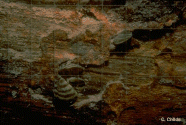
|
National Sea Grant Network Exotic Species Graphics Library
Zebra mussels attached to shipwreck’s wooden hull.
Photo by Chet Childs
Click image to enlarge
|
|
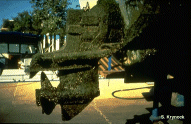
|
National Sea Grant Network Exotic Species Graphics Library
Mussels on the lower unit of an inboard/outboard engine.
Photo by Steve Krynock
Click image to enlarge
|
|
|
|
Top of Page
|
Where are zebra mussels currently found?
|
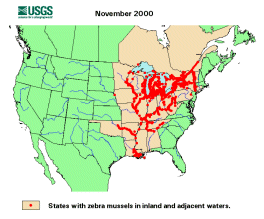
|
USGS/Florida Caribbean Science Center
Click image to enlarge
|
- As a native to Russia, zebra mussels were introduced into the Great Lakes in 1985 or 1986, when one or more transoceanic ships discharged ballast water into Lake St. Clair. Being a temperate, freshwater species, the zebra mussels found the plankton-rich Lakes St. Clair and Erie to their liking. Since this time, zebra mussels have spread throughout the Great Lakes, the Ohio River Basin and the Mississippi River Basin. Colonies have been found as far west as Oklahoma and live zebra mussels have been found attached to recreational boats transported to Washington state. As of 1994, the following states had reported records of zebra mussels within their borders or in water bodies adjacent to their borders: Alabama, Arkansas, Illinois, Indiana, Iowa, Kentucky, Louisiana, Michigan, Minnesota, Mississippi, Missouri, New York, Ohio, Oklahoma, Pennsylvania, Tennessee, Vermont, West Virginia, and Wisconsin. More recently, Connecticut has been added to the list of states where zebra mussels have been found.
|
|
Top of Page
|
What is the potential for zebra mussels to spread elsewhere in U.S.?
|
- The potential for zebra mussels to spread is very high. In fact, several bills are in front of Congress that focus on preventing the westward spread of zebra mussels. These hitchhikers can spread to other inland waters either in their immature form known as veligers transported in water or as adults attached to boat hulls, engines, aquatic weeds, or other surfaces. Veligers are small-about the size of the period at the end of this sentence-and may be able to survive in any residual water source.
Adult mussels are very hardy and can survive out of water for extended periods depending upon temperature, humidity, wind, and sunlight. Maximum out-of-water survival time in ideal conditions is about 10 days for adults and 3 days for newly-settled juveniles.
|
|
Top of Page
|
Short term benefits of zebra mussels don’t override long term impacts
|

|
Weed growth caused by zebra mussels increasing water clarity.
NOAA, Great Lakes Environmental Research Laboratory
Click image to enlarge
|
- Originally, when zebra mussels entered Lake Erie, the public saw the positive impacts of their filter feeding that cleaned up the lake. Zebra mussels contributed to the improvement of Lake Erie's water clarity. Research shows that in the early ‘70s, water clarity was approximately 3 feet. It improved to 6 to 10 feet in the 1980s after a decade of reduced phosphorus inputs, and improved again to 10 to 17 feet in the early 1990s, after zebra mussels colonized the area. However, while the water may have better clarity, the negative impacts outweigh this one positive benefit. One result of clearer water is increased vegetative growth, which may not be the best thing for anglers, boaters, swimmers and other aquatic recreation users.
|
|
Top of Page
|
How can I prevent the spread of zebra mussels?
|
- Remove any visible vegetation from items that were in the water, including the boat, trailer, and all equipment.
- Flush engine cooling system, live wells, and bilge with tap water. If possible, use hot water.
- Do not re-use bait if exposed to infested waters.
- Dry boat and other equipment for at least 48 hours before using in uninfested waters.
- Examine boat exterior for mussels if it has been docked in infested waters; if mussels are found or exterior is heavily fouled by algae, either clean fouled surfaces or leave boat out of the water for at least 5 days before entering uninfested waters.
|
|
Top of Page
|
What else can I do?
|
|
|
|
Top of Page
|
References
|
- Zebra Mussels in North America Fact Sheet 045. Ohio Sea Grant College Program. www.sg.ohio-state.edu/publications/nuisances/zebras/fs-045.html
- NOAA, Great Lakes Environmental Research Laboratory
- USGS, Florida Caribbean Science Center
- National Sea Grant Network Exotic Species Graphics Library
|
|
Top of Page
|
Back to Harmful Aquatic Hitchhikers
|

The Stop Aquatic Hitchhikers web site is part of the ANS Task Force public
awareness campaign and is sponsored by the
U.S. Fish and Wildlife Service
and the U.S. Coast Guard.
|
|
|
 |
|
Partnership Opportunities
|
- Current Partners
- Become a Partner
|
|
State Info Pages
|
|
News
|
Check out the Latest News about the Stop Aquatic Hitchhiker Campaign and the Expanding Aquatic Hitchhiker Problem.
Test your aquatic nuisance species knowledge with the Who Wants To Be A Fish Biologist game.
|
|
Recreational Activities
|
Boating, Fishing, Swimming, Waterfowl Hunting, SCUBA Diving or Snorkeling, Windsurfing, Seaplane Operations, Personal Watercraft Use, Recreational Bait Harvesting
| |
Common Hitchhikers
|
Zebra Mussels, Hydrilla, Whirling Disease, Spiny Water Fleas, Round Gobies, Water Hyacinth
|
|
Video Clips
|
Asian Carp in the Upper Mississippi River
(Real Video format)
Round Goby
(Quicktime Format)
|
|
New Audio Messages for Traveler
Information Systems |
Zebra Mussel (mp3)
Zebra Mussel #2 (mp3)
|
|
E-Mail News List
|
|
Stop Aquatic Hitchhikers! email news. Delievered right to your inbox. |
|
|
|
E-Mail Site to a friend
|
|
|
|
|
|